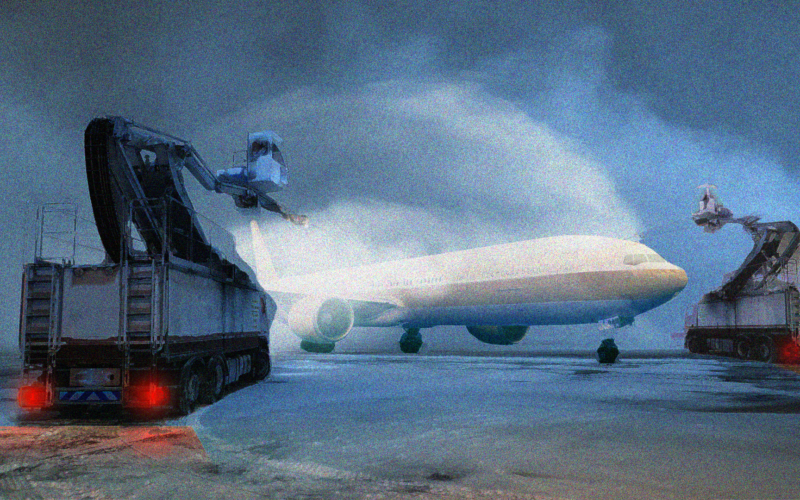In operation 24 hours a day, 365 days a year, aviation must adapt to all climates and conditions.
Severe weather can mean enormous costs for both airlines and airports through delays and cancellations, along with the bad publicity during disruptive periods.
In December 2010, Europe was faced with severe adverse conditions in the week before Christmas. Frankfurt airport recorded more than 246 flight cancellations in a single day, while Charles de Gaulle airport in Paris had shortages of de-icing fluid.
To minimize disruption and maintain safety, airlines and airports provide training and publish detailed winter plans to help cope with severe winter weather.
Clean Aircraft Concept
One of the most serious threats to flight safety is the presence of snow, frost and ice on the wings, known as wing contamination. Throughout aviation history, this has caused many accidents.
In January 1982, for example, Air Florida Flight 90 crashed into an icy Potomac River only 30 seconds after take-off from Washington National Airport, killing 78 people.
The main cause of the accident was the presence of ice and snow on critical surfaces of the aircraft.
Contamination of ice, snow or frost on an aircraft surface has two serious impacts: increased weight and reduced aircraft performance, including a higher stall speed and reduced lift.
A mere three mm of frost can increase the distance an aircraft needs to take off by more than 80%.
To prevent accidents such as Flight 90, airlines and aviation bodies support the Clean Aircraft Concept meaning that no aircraft should take off with any critical surfaces contaminated. This is achieved by de-icing and anti-icing.
De-icing vs Anti-icing
De-icing is the removal of any ice or snow from the aircraft surfaces and is usually completed on stand before pushback. An aircraft can be de-iced using fluid or by mechanical means.
Extreme care must be taken when applying any fluid to an aircraft surface. There are specific no-spray areas, such as antennas, windows, landing gear, instrument probes, and the engines.
Anti-icing is a preventative process completed after the removal of any ice, snow or frost. It provides protection for a limited time period known as a holdover time (HOT).
Pilots refer to HOT tables to determine the maximum time period for the prevailing conditions and fluid used before the aircraft has to undergo another de-icing procedure.
During flight, aircraft use anti-ice systems built into the engines and wings. Pneumatic de-icing boots are common on smaller aircraft, which expand to break off any ice on the wings.
Jet aircraft use warm bleed air from the engines which is directed through tubes close to the wing surface. Aircraft such as the Boeing 787 use more efficient electro thermal coils.
Before aircraft are certified, they undergo extreme weather testing, in conditions as cold as -35 Celsius for many hours, during which all the systems are tested and monitored.
Winter forecasts
Airports rely on meteorology forecasts to predict and plan for winter weather. Up to five days out, forecasts are produced detailing any extreme weather.
Aside from snow, frost and ice, airport forecasts often include lesser-known weather phenomena:
Freezing Rain (FZRA)
Freezing Drizzle (FZDZ)
Freezing Fog (FZFG)
Snow Pellets (GS)
Light freezing rain (-FZRA) is the condition with the shortest holdover time of any kind of bad weather, including snow. This is because freezing rain will freeze almost instantly after touching a cold surface such as an aircraft.
Aprons, taxiways and runways
In spite of all of the above, if the airport itself isn’t clear of snow and ice, aircraft won’t be going anywhere.
Major airports have fleets of snow-clearing vehicles which work around the clock to keep the taxiways, aprons and, most importantly, the runways clear and safe to use.
Airport surfaces can be pre-treated with anti-ice solutions to prevent ice and snow build-up, but when conditions are too bad, the airport operation manager will close the runway.
In a highly coordinated effort, teams will begin to clear the snow. Depending on the extent of the snow and the size of the runway, this can take up significant time especially if snowfall continues during the clearing.
For airports more used to dealing with winter weather, snow clearing can take as little as 20 minutes, minimizing runway closures and flight delays.
Once the runway is cleared, the airport authorities measure the surface friction to determine whether it is safe to be reopened for aircraft.
Although frustrating, the next time you are delayed at an airport in wintry weather, take some comfort in knowing that safety is a priority.

